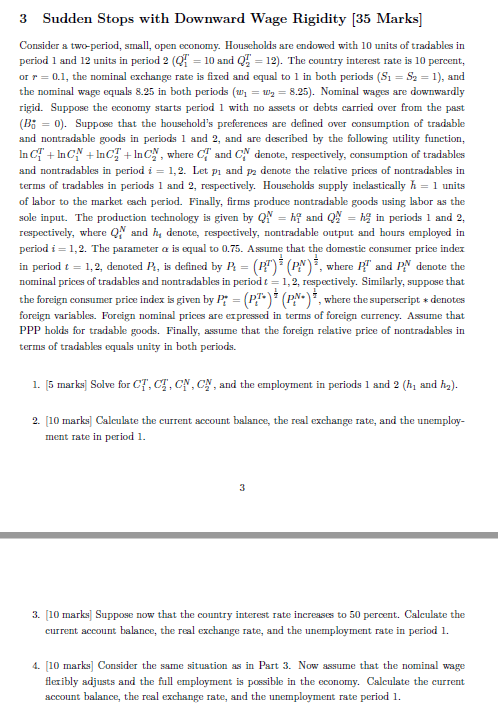Answered step by step
Verified Expert Solution
Question
1 Approved Answer
Need questions 3 and 4 only. 3 Sudden Stops with Downward Wage Rigidity (35 Marks] Consider a two-period, small, open economy. Households are endowed with

Need questions 3 and 4 only.
3 Sudden Stops with Downward Wage Rigidity (35 Marks] Consider a two-period, small, open economy. Households are endowed with 10 units of tradables in period 1 and 12 units in period 2 (0 = 10 and Q = 12). The country interest rate is 10 percent, or r=0.1, the nominal exchange rate is fized and equal to 1 in both periods (S1 = S2 = 1), and the nominal wage equals 8.25 in both periods (w = 2y = 8.25). Nominal wages are downwardly rigid. Suppose the economy starts period 1 with no assets or debts carried over from the past (Bi = 0). Suppose that the household's preferences are defined over consumption of tradable and nontradable goods in periods 1 and 2, and are described by the following utility function, In c' + InCN + Inch + lncy, where and CV denote, respectively, consumption of tradables and nontradables in period i = 1,2. Let pi and p denote the relative prices of nontradables in terms of tradables in periods 1 and 2, respectively. Households supply inelastically h = 1 units of labor to the market each period. Finally, firms produce nontradable goods using labor as the sole input. The production technology is given by ON = hi and Q = h in periods 1 and 2, respectively, where on and hy denote, respectively, nontradable output and hours employed in period i=1,2. The parameter a is equal to 0.75. Assume that the domestic consumer price index in period e = 1, 2, denoted P., is defined by R = (?")* (PN), where and PN denote the nominal prices of tradables and nontradables in period t = 1, 2, respectively. Similarly, suppose that the foreign consumer price index is given by P; = (PT") * (PN), where the superscript + denotes foreign variables. Foreign nominal prices are expressed in terms of foreign currency. Assume that PPP holds for tradable goods. Finally, assume that the foreign relative price of nontradables in terms of tradables equals unity in both periods. 1. 15 marks] Solve for CT, C, CNC, and the employment in periods 1 and 2 (h, and hy). 2. [10 marks) Calculate the current account balance, the real exchange rate, and the unemploy- ment rate in period 1. 3 3. [10 marks] Suppose now that the country interest rate increases to 50 percent. Calculate the current account balance, the real exchange rate, and the unemployment rate in period 1. 4. [10 marks] Consider the same situation as in Part 3. Now assume that the nominal wage flexibly adjusts and the full employment is possible in the economy. Calculate the current account balance, the real exchange rate, and the unemployment rate period 1. 3 Sudden Stops with Downward Wage Rigidity (35 Marks] Consider a two-period, small, open economy. Households are endowed with 10 units of tradables in period 1 and 12 units in period 2 (0 = 10 and Q = 12). The country interest rate is 10 percent, or r=0.1, the nominal exchange rate is fized and equal to 1 in both periods (S1 = S2 = 1), and the nominal wage equals 8.25 in both periods (w = 2y = 8.25). Nominal wages are downwardly rigid. Suppose the economy starts period 1 with no assets or debts carried over from the past (Bi = 0). Suppose that the household's preferences are defined over consumption of tradable and nontradable goods in periods 1 and 2, and are described by the following utility function, In c' + InCN + Inch + lncy, where and CV denote, respectively, consumption of tradables and nontradables in period i = 1,2. Let pi and p denote the relative prices of nontradables in terms of tradables in periods 1 and 2, respectively. Households supply inelastically h = 1 units of labor to the market each period. Finally, firms produce nontradable goods using labor as the sole input. The production technology is given by ON = hi and Q = h in periods 1 and 2, respectively, where on and hy denote, respectively, nontradable output and hours employed in period i=1,2. The parameter a is equal to 0.75. Assume that the domestic consumer price index in period e = 1, 2, denoted P., is defined by R = (?")* (PN), where and PN denote the nominal prices of tradables and nontradables in period t = 1, 2, respectively. Similarly, suppose that the foreign consumer price index is given by P; = (PT") * (PN), where the superscript + denotes foreign variables. Foreign nominal prices are expressed in terms of foreign currency. Assume that PPP holds for tradable goods. Finally, assume that the foreign relative price of nontradables in terms of tradables equals unity in both periods. 1. 15 marks] Solve for CT, C, CNC, and the employment in periods 1 and 2 (h, and hy). 2. [10 marks) Calculate the current account balance, the real exchange rate, and the unemploy- ment rate in period 1. 3 3. [10 marks] Suppose now that the country interest rate increases to 50 percent. Calculate the current account balance, the real exchange rate, and the unemployment rate in period 1. 4. [10 marks] Consider the same situation as in Part 3. Now assume that the nominal wage flexibly adjusts and the full employment is possible in the economy. Calculate the current account balance, the real exchange rate, and the unemployment rate period 1Step by Step Solution
There are 3 Steps involved in it
Step: 1

Get Instant Access to Expert-Tailored Solutions
See step-by-step solutions with expert insights and AI powered tools for academic success
Step: 2

Step: 3

Ace Your Homework with AI
Get the answers you need in no time with our AI-driven, step-by-step assistance
Get Started


